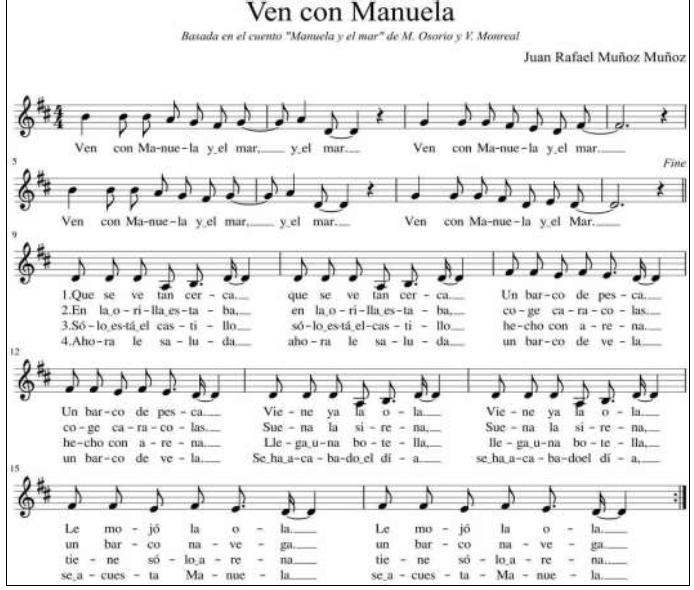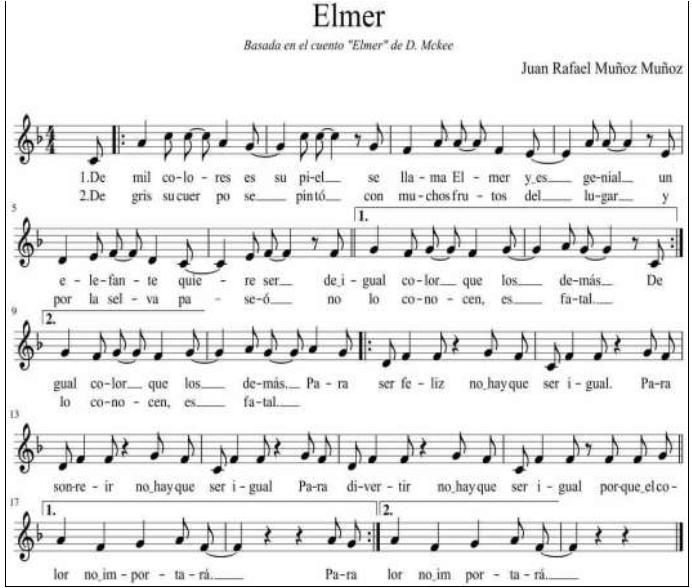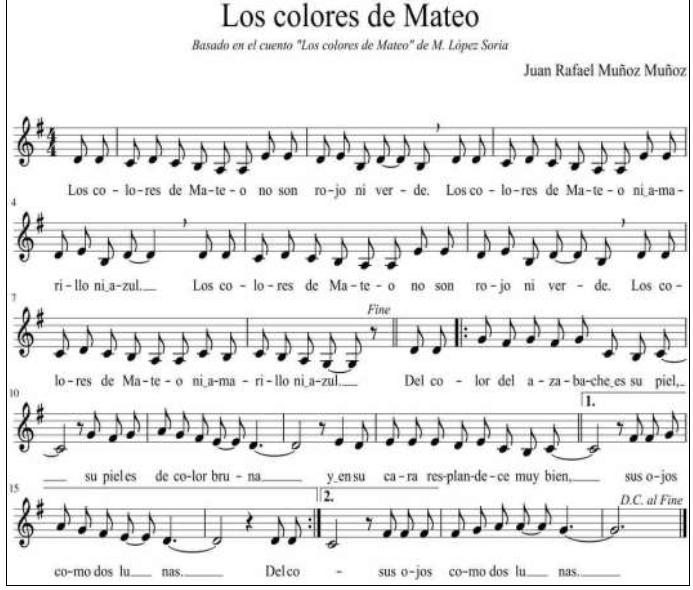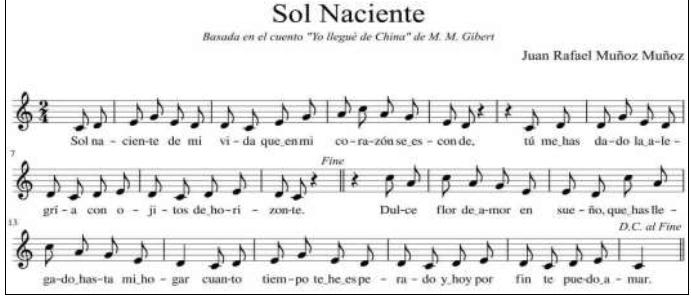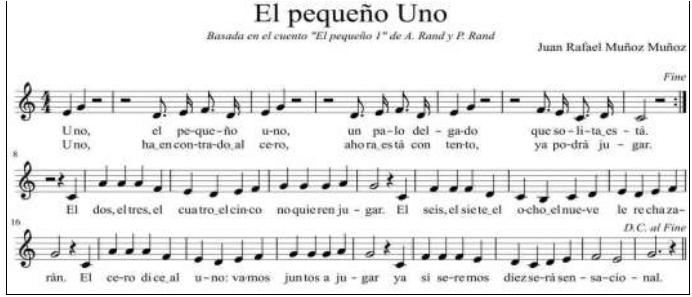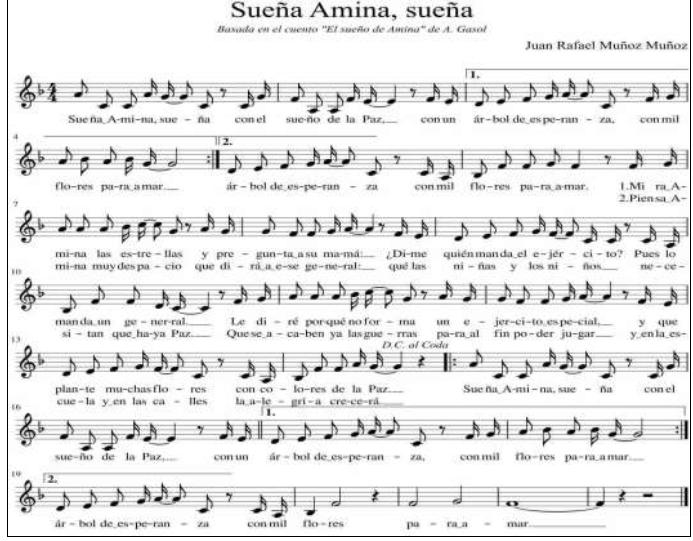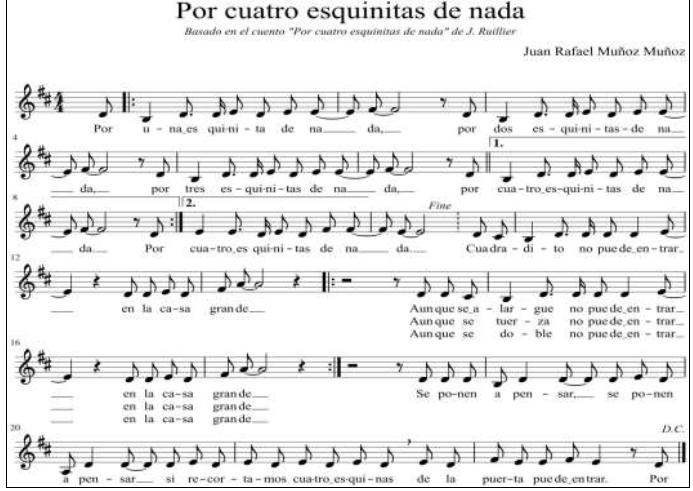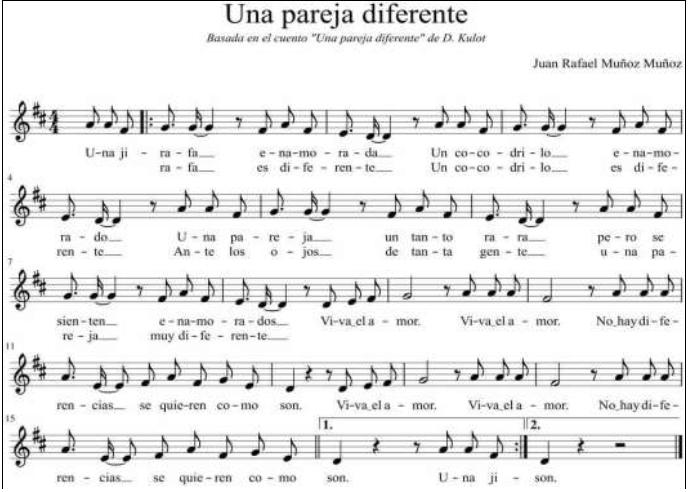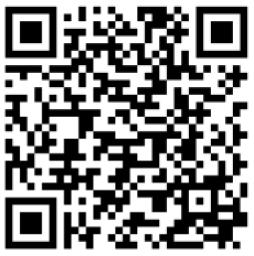Serviços Personalizados
Journal
Artigo
Compartilhar
Educação & Formação
versão On-line ISSN 2448-3583
Educ. Form. vol.8 Fortaleza 2023 Epub 02-Jan-2024
https://doi.org/10.25053/redufor.v8.e10617
ARTICLE
Intercultural educa[n]tion: songs based on tales as a means of intercultural education
iUniversity of Almería, Almería, Spain. E-mail: jrmunoz@ual.es
iiUniversity of Almería, Almería, Spain. E-mail: jgonzal@ual.es
Singing is one of the main activities carried out in the field of musical education, promoting social relations and favouring integration. The song is the main protagonist in this activity, and its use as a means to promote education in values and interculturality is becoming increasingly common. Their theme and the contexts they invoke facilitate the treatment of education for peace, acceptance and respect, coeducation, and cultural diversity. This article presents a repertoire of songs that are part of the training of students in the Degrees of Early Childhood and Primary Education at the University of Almería (Spain), as well as schools in Almería that participate in didactic and solidarity concerts.
Keywords: songs; education in values; emotions; integration; interculturality
El canto es una de las principales actividades que se realizan en el ámbito de la educación musical, fomentándose las relaciones sociales y favoreciéndose la integración. La canción es la principal protagonista en esta actividad y su utilización como medio para potenciar la educación en valores y la interculturalidad es cada vez más habitual. Su temática y los contextos que evocan facilitan el tratamiento de la educación para la paz, la aceptación y el respeto, la coeducación y la diversidad cultural. En este artículo se presenta un repertorio de canciones que forman parte de la formación del alumnado de los grados de educación infantil y primaria de la Universidad de Almería (España) así como de centros escolares de Almería y provincia que participan en conciertos didácticos y solidarios.
Palabras clave: canciones; educación en valores; emociones; integración; interculturalidad
O canto é uma das principais atividades desenvolvidas no âmbito da educação musical, promovendo relações sociais e favorecendo a integração. A música é a principal protagonista desta atividade e a sua utilização como meio de promover a educação em valores e a interculturalidade é cada vez mais comum. A sua temática e os contextos que evocam facilitam o tratamento da educação para a paz, o acolhimento, o respeito, a coeducação e a diversidade cultural. Este artigo apresenta um repertório de canções que fazem parte da formação de alunos de educação infantil e primária da Universidade de Almeria (Espanha), bem como de escolas de Almeria e da província que participam de concertos didáticos e solidários.
Palavras-chave: canções; educação em valores; emoções; integração; interculturalidade
1 Introduction
Interculturality is defined as “[...] the presence and equal interaction of diverse cultures and the possibility of generating shared cultural expressions through dialogue and mutual respect” (Unesco, 2005, p. 16). Consequently, understanding interculturality as a space for encounter and knowledge that favors equality not only between different ethnic, linguistic, or religious groups, as it has traditionally been understood. A broader understanding also favors girls and boys, young and old, taking into account different sexual or gender identities, as well as family diversity and new family models, would be an important educational factor for an inclusive citizenship.
For this reason, the school must be the space in which socio-emotional skills are developed that allow for an adequate response to the challenges represented by interculturality and diversity, using educational skills that promote didactic resources, such as songs, that favor a broader knowledge of reality and allow make up for inequalities, strengthening coexistence (Pedrero-García; Moreno-Fernández; Moreno-Crespo, 2017).
In turn, singing is present in our lives from an early age through the melodies that are sung to babies in the family environment, being a connection and communication between mother and child (Morant, 1999). From a cultural standpoint, singing is part of the basic elements that define cultures, as Kodaly points out: “A profound musical culture only developed when singing was the basis. The human voice is accessible to everyone and, at the same time, constitutes the most perfect and most beautiful instrument and must be the basis of the musical culture of the masses” (Ördög, 2000, p. 6).
In addition, in the development of these cultures, singing has been used as a means of expressing feelings, sensations, emotions, and human experiences. In this sense, Willems (1981, p. 140) even states that “[...] it can be safely said that singing is the principle and soul of music”. From the point of view of its importance in the educational field, it is worth highlighting how, through singing, it is possible to develop skills that are not exclusively musical, related to the field of audio perception (Monks, 2003) or even to the improvement of psychomotor skills (Phillips, 2014).
Normally, in singing, attention is focused on these aspects that we present; however, there are others linked to education in values that have special relevance in this activity, especially when carried out in a group. The action of singing requires the willingness of the participants to demonstrate solidarity, as the final result will be the sum of the contributions of each of the people involved. This solidarity determines that teamwork is a basic pillar for their development and, for this to be possible, it is essential that all singers feel part of the group and, therefore, that everyone feels included in it. It is difficult to think that it is possible to sing in a group if its members do not accept, respect, and value each other, as there would be no way to control one's own interpretation and, above all, the influence of personal emotions in singing. Therefore, when we propose a singing activity in the classroom, regardless of the level at which it is performed, we are offering the possibility of improving students' social relationships and promoting solidarity and integration of all girls and boys, regardless of gender, race, culture, religion, or socioeconomic status.
This dimension of singing as a means of promoting integration and interculturality is even more accentuated when a suitable selection that will be part of the repertoire of our classroom of songs is made. The theme of each song will lead students to all aspects related to interculturality. In this way, the idea is strengthened that the school develops values that favor the acceptance and integration of people, making use of the knowledge of the culture of each society (Bitir; Duran, 2019).
2 Songs as a means for dealing with intercultural education
In the context of music education, in addition to the importance of children's songs, it is important to highlight their role in integrating different areas of knowledge, both in early childhood education and in elementary school (Estévez Vila, 2006; López de la Calle Sampedro, 2007; Martín Escobar, 2002). Its relevance in children's musical education has often been pointed out, to the point of being considered by Hemsy de Gainza (1964, p. 113) as “[...] the most important musical food that the child receives”. Its repercussion in the educational field is addressed by Bernal Vázquez and Calvo Niño (2000, p. 83), who point out its contribution not only to musical learning but also to learning in other areas of knowledge, as children's songs “[...] is an excellent didactic resource because it requests the direct and active participation of the child, which makes it a basic element, both at the level of early childhood musical education and for the learning and internalization of other areas of the curriculum”.
Its didactic justification should be highlighted by the possibilities it offers in the field of integral education of children. (Cámara Izagirre, 2005; Oriol de Alarcón; Parra, 1979). In this line, the use of songs is promoted as a means for developing other skills, such as memorizing melodies or texts, while offering an inexhaustible source of vocabulary and a connection with different subjects in different areas of knowledge (Pérez Miguel, 2003). In this perspective, Muñoz Muñoz (2003) highlights the song as the most complete and global context of musical work that is usually used in the classroom and which is capable of integrating musical and extramusical skills and content.
The use of songs based on stories, poetry, and other literary works makes it easy for children to approach their first readings, so songs can be used as a means of encouraging reading in early childhood education (Muñoz Muñoz, 2022). But at the same time, music has an active presence in their emotional education, with the frequent use of songs and singing as a means of promoting emotional development (Bisquerra, 2017).
Music favors education in values at different educational levels (Conejo Rodríguez, 2012). Through songs and chants, intercultural education and respect for others without differences of race, sex, or religion are promoted (Bernabé, 2013). Likewise, they contribute to the training of children in education for peace and non-violence, promoting attitudes and behaviors typical in a peaceful culture (Cabedo-Mas; Moreno, 2018). The promotion of values through songs and singing offers the advantage of being able to start in early childhood education and continue throughout elementary school (Moya Martínez et al., 2014).
Epelde Larrañaga (2011) also proposes to educate from an intercultural approach with the use of songs that offer the possibility of establishing relationships between music and literary text, working together with the area of Language and Literature (Quiles, 2008). In cases when the literary genre used is a story for which a song is composed based on it, the work will be even more complete, while an interdisciplinary didactic approach will be developed that will favor deeper learning for the students (García Sánchez, 2016).
3 Children's and youth adult's literature for the development of intercultural proposals
Children's and youth adults' literature is a reflection of the real situation of the context in which it is generated and developed, as well as the values it transmits (Gárate, 1997), at the same time as it is a reference that contributes to the strengthening of identities and feelings of belonging to the group and society, but also has a pedagogical function:
[...] it is about educating citizens who assume diversity, multiple belonging, and uniqueness as individual and collective wealth; furthermore [...] we must go beyond simple tolerance to reach respect and positive acceptance of difference as an enriching element; Finally, we must arrive at the simultaneous affirmation of the personal right to singularity, the right of others to be singular, the right to difference and openness to universality as complementary and assumable elements (Oltra Albiach, 2011, p. 1768).
As Mínguez López and Olmos Fontestad (2013) point out, children's and youth adults' literature does not have the obligation to change our society, but it must at least reflect it. Through them, we can find ways to address issues such as respect and equality, but also to make a difference not be perceived as a difficulty but as an opportunity:
The idea of difference implied, for LIJ, an opportunity to generate content that portrays and highlights, through a critical perspective, what happens in the social world, resorting to different aesthetic languages, such as the spoken word, sung and illustrated, which, through a poetic reason, present and speak of those we deem unlikely to speak, in a careful, delicate and sensitive way (Duque Cardona, 2022, p. 44).
The use of this literature begins in early childhood education with the selection of stories that are used regularly in the classroom. In the same way that they represent a direct contact with the promotion of reading and writing (López Martín, 2017), they also represent a valuable way to approach the contents of different areas of knowledge. At the same time, the use of stories makes it easy the development of imagination and creativity (Borislavovna Borislova, 2017). All these arguments mean that songs are considered one of the main didactic resources for working on different areas and contents in early childhood education and elementary school (Jiménez Frías et al., 2001; Martínez-Antequera; Dalouh; Soriano-Ayala, 2020).
4 Focus on using music to address interculturality
We will use songs based on stories as an axis for the development of our work proposal. Stories are a fundamental element as a didactic resource in early childhood education and elementary school, due to the educational possibilities and advantages they offer us. The inclusion of these songs favors the creation of an interdisciplinary curriculum that allows meaningful learning about justice, power, dignity, and self-esteem (Beane; Appel, 1997), based on democracy, equality, dialogue, participation, and pluralism (Aguilar, 2009).
The characters, the moments, the situations, the actions, and the world of reality, fantasy, and dreams will help us to take the students to different moments that will serve as experiences of the themes that we intend to approach (Nobile, 1992).
The songs we use are based on children's stories or literary works whose themes are related to interculturality. The text of these songs tries to offer a synthesized idea of the story's content on which it is based, the main actions that take place, and its characters. Through it, students can be introduced to the observation, identification, knowledge, and awareness of aspects related to diversity and interculturality.
The text of the songs occupies an important place in their use, as the educational level for which each song is intended and the activities to be carried out with the song will depend on it. On the other hand, the characteristics of the text: vocabulary, phrases, size, or even its simplicity or complexity for memorization, will have to be adapted to the knowledge, experiences, and perceptions of the children for whom the text is intended. Thus, we will be able to facilitate the understanding of the songs and the setup of the songs for interpretation quickly and directly.
The rhythm of the songs must be simple, without major contrasts, repetitive, and, at the same time, striking, stimulating, and motivating, to generate a desire to learn them and participate in the activities that we want to propose with each one of them. In the same way, the melody must have the same characteristics as the rhythm: simple, without big leaps between notes, and repetitive. If the rhythm and melody do not attract the students' attention, it will be difficult for them to demonstrate an adequate disposition for the activities that will be carried out.
Its presence is also common in teacher training and teacher training courses and in other activities, such as didactic concerts for schools and families. Every year, a series of educational concerts are held at the University of Almeria and elsewhere in the province, with the participation of more than 7,000 children from kindergarten, early childhood education, and elementary schools. In these concerts, songs based on stories that the children worked on in their schools form the core of the repertoire of these concerts.
5 Story-based song activities for intercultural development
The proposal to work with songs based on stories and literary works means that we have to pay special attention to the selection of stories and songs that we are going to use. In this proposal, we opted for a series of stories that approach issues related to interculturality in different ways, considering that all of them have a song written about their content. Its themes will take us to the culture of different countries and ethnic groups and, at the same time, will address issues related to diversity, solidarity, integration, acceptance, and respect for all people, without any type of discrimination.
The activities that we can carry out with songs based on stories can be classified as follows:
The presentation of these activities is not prescriptive but intends to serve as a guide for teachers who wish to use stories with songs based on them in their classrooms.
5.1 Storytelling activities
It is important to plan how to introduce children to the story on which the song we are going to work is based. Depending on their characteristics, we can use different strategies:
Reading the story: we must take advantage of the possibilities offered by the voice to help capture the students' attention, either to give personality to each of the characters or to emphasize the actions they carry out in the development of the story.
Story narration: allows for a freer presentation and greater adaptability to the circumstances and characteristics of the students.
Story enactment: traditionally, this is done when the story is known. However, here we propose to use it as a strategy to tell the story.
5.2 Musical activities
Musical activities with story-based songs are not very different from those we develop with other songs. They can be as varied as we want, depending on the time available and the age and knowledge of the students. We can change the key, increase or decrease the playing time, use just the chorus or the chorus and a verse, even if we have more verses. Depending on the vocabulary of the text, the music, and the structure, some are suitable for early childhood education and elementary school, and others for elementary school and middle years. It will be up to each teacher to decide the level of use and the classes in which they want to work with.
Among other activities, we could have:
The setup of music, by imitation, repetition, or decoding: the use of imitation and repetition will depend on the characteristics of the music we are working with and, above all, on the length and complexity of its text. This process of decoding will depend on the level of knowledge of the musical language that the children have acquired. We must take into account that the setup by imitation and repetition facilitates the quick learning of the music and the fluid participation of the students, almost from the first moment.
Music interpretation: the interpretation of music can have an infinite number of variables. We can make an interpretation that simply fits what is established in the music, but we can also make interpretations in which simple variations of timbre, intensity, duration, and tone are performed (Muñoz Muñoz, 2021). Other performances may focus on interpretations of different genres and styles.
Instrumental accompaniment: accompaniment, like montage, can be accomplished by imitation, repetition, and decoding. We will focus on imitation and repetition-based accompaniment. In short, it is a simple follow-up, based on following the instructions given by the teacher during the process. Initially, the instruments to be used are: natural instruments of the body, objects from the environment, and small percussion instruments of indeterminate sound (small drum, claves, triangle, maracas, tambourine...). At other times, we can use small percussion instruments with a specific sound (bells, xylophones, metallophones...) and other conventional instruments.
Gesture and movement tracking: gestural and movement accompaniment is also accomplished by imitation and repetition. Its greatest importance lies in allowing children to intervene in the interpretation of music from the beginning, even if they do not know it (Muñoz Muñoz, 2021). Simply imitating the teacher, from the beginning of the song, it can be accompanied by simple gestures and movements.
5.3 Analysis, comments, and awareness activities on the subject
Analysis, comments, and awareness of intercultural aspects can be carried out at different times in the story-based song work session. Some of these can be done at the beginning, to serve as a backdrop for what will be covered; others are developed during the working session, after the story has been told or the song has been sung for the first time; finally, others are proposed as a final phase of the work to carry out an evaluation and awareness of what we are approaching:
Contact activities and prior knowledge: at the beginning, contact activities will be used so that students can be informed, but also to motivate them regarding the subject that will be covered. At the same time, we will use them to find out the prior knowledge students have on the subject.
Analysis activities: are proposed during or at the end of the class. A good moment is when the reading, narration, or staging of the story ends; when the theme, actions, characters, and, in short, everything related to the content of the story are covered. Another good time for this type of activity is when the music ends. We can comment on the content of the lyrics and their relationship to what we know about the story. This will take us, once again, to the specific topic we are focusing our attention on. In all these activities, the objective is for students to be able to exchange opinions on this topic, express themselves orally about it, and learn their classmates' opinions, as well as any other complementary information that the teacher can provide.
Awareness activities: these activities will help us to value, respect, and consider all issues related to interculturality. The exchange of ideas, debate, and oral presentations will help us demonstrate positive attitudes related to our topic. Through them, children acquire personal commitments to make these attitudes a reality, both in the classroom, at home, and in their daily lives. These commitments are simple, but at the same time, they are real and within their reach. These are, in short, intercultural awareness activities.
6 The development of musical activities and interculturality
The musical activities we propose can adapt to the knowledge, experiences, and characteristics of any type of student. Carrying out these activities in groups offers us the possibility of developing work and coexistence situations in which all students can be truly included. Vocal, instrumental and movement execution or accompaniment favors the integration of members to the class-group. And, if the selected works allow a direct relationship between the students' cultures, a rich and varied intercultural context will be promoted, which will help to understand the cultural reality of each of them.
Teamwork generates solidarity, cooperation, and support, always respecting others and valuing the roles that each one plays to obtain final products, the result of the effort and contributions of all students. At the same time, situations are created in which children can live in groups and comment on different information related to the content of stories and songs and, therefore, aspects linked to interculturality. The flexibility of the groups and the rotations we propose in them are helping to strengthen relationships between members and everyone's acceptance. In this way, effective inclusion without conditions or differentiation will always be favored.
On the other hand, when the age of the students and the characteristics of the activities to be carried out allow it, they will be planning the work. These situations generate exchanges of ideas, debates, and the search for information, which, once again, will put students in contact with the intercultural topic being addressed at the moment.
The selection process took into account the history and its relationship with aspects linked to diversity, inclusion, and interculturality. This selection was carried out by different educational centers that were interested in working on this topic with their students. A song was written for each of them when necessary, with musical characteristics, a structure, and a text that could be adapted to different educational levels. Likewise, it was specifically considered that its melody and rhythm allow rapid interaction and participation of students. These songs have been used by these centers and many others, and have been disseminated through various teacher training activities and social media. At the same time, they are part of the repertoire used at the University with students on teacher training courses in early childhood and elementary education and the repertoire of presentations and Didactic Concerts that are organized for schools.
All activities described above can be carried out with each of the selected stories and songs. Furthermore, the work we are going to develop allows us to simultaneously address a series of values and emotions. Likewise, we can establish the connections we consider appropriate with possible projects, areas of knowledge, and different contexts.
Obviously, it is not necessary to carry out all the proposals. However, the diversity of the options will enable the same story to be used at different educational levels when considered appropriate. The stories and songs selected take into account the characteristics of early childhood education and elementary school students for whom they are intended. They are as follows.
6.1 Manuela and the sea
Manuela y el mar is a story written by María Osorio with illustrations by Violeta Monreal (1993), in which the main character is a gypsy girl and which also includes different fragments of flamenco. In our classrooms, there are gypsy children who will allow us to learn about their customs and traditions. At the same time, we will get closer to the world of flamenco, with which the gypsy ethnic group is so closely related. In emotional terms, Manuela's joy in discovering the sea for the first time stands out. The duplicity of phrases in the chorus causes students to imitate the phrase presented by the teacher. It is a story and a song that can be used mainly in early childhood education and in elementary school to celebrate Flamenco Day, as well as in projects that have the gypsy ethnic group as a theme.
6.2 Elmer
Elmer, written and illustrated by David McKee (2003), brings us closer to diversity through personal self-esteem. Although sometimes we may think that the best thing to do is to be exactly the same as everyone else, self-acceptance leads us to positively understand that we are all different. Differences in skin color are dealt with simply, and we need to note that this issue should not influence us to understand that we are all the same. The important thing is to accept each of us as we are, and that's why Elmer's sadness turns to joy when he realizes that everyone loves him as he is. This is a story and a song that is often used in early childhood and elementary education by a large number of schools to celebrate Peace Day.
6.3 Los colores de Mateo
Los colores de Mateo, by María López Soria and illustrations by Katarzyna Rogowicz (2003), is a story about the diversity of an adopted child who becomes aware of who he is and feels happy about it. The anger and confrontations with some classmates because of the color of his skin cease when Mateo accepts the color of his skin and, at the same time, feels happy to have been adopted by a family that loves him. Children, especially those from Sub-Saharan Africa, are very present in our country's classrooms, especially in Andalusia. With this story and its song, we promote acceptance and respect for these students in the context of their full integration into everyday life. Mateo exists in reality and we meet him through the story's author, Marisa López Soria. It is often used in many schools to celebrate Peace Day.
6.4 Llegué... de China. Cuéntame mi historia
Llegué... de China. Cuéntame mi historia, by Miquel M. Gibert, with illustrations by Luci Gutiérrez (2006), also reflects the case of international adoption in which the protagonist is a girl from China who arrives to brighten the life of a Western family. The song - and the use of this story - arises from the presence of this girl in one of our classrooms and brings us closer to the reality of getting to know other cultures and, at the same time, raises a real situation in our society.
6.5 El pequeño Uno
El pequeño Uno, by Ann Rand, with illustrations by Paul Rand (2006), is fundamentally about friendship. Although no one wants to play with little Uno, everything changes when he meets “Zero”. The rejection demonstrated by the rest of the characters makes us think and become aware of the repercussions of this type of attitude. Unity with “Zero” is the first step towards normalizing relationships with others and making him feel accepted by everyone. In this case, sadness turns into joy when this happens in a story that reminds us of the need to accept everyone as they are and to share our lives with them. On the other hand, it allows us to approach the world of mathematics from the point of view of diversity.
6.6 El sueño de Amina
El sueño de Amina, written by Anna Gasol and illustrated by Mariona Cabassa Cortés (2011), takes us to war environments in different countries, where children need to play, study, and live like other children in other places that do not have to deal with armed conflicts. Amina thinks how wonderful it would be to exchange weapons for flowers to make them happy. It is an opportunity to raise awareness about these children's situation and to show solidarity with them so that they can grow up in a world of peace. It also helps us appreciate the fear and sadness of war and, in the face of it, the joy and love of peace.
6.7 Por cuatro esquinitas de nada
In Por cuatro esquinitas de nada, written and illustrated by Jerome Ruillier (2014), we see that the main character would like to be like the others, as the “cuadradito” cannot be the same as the “redonditos”, to enter through the round door of the big house. The initial proposal of the “little rounds” was to cut the corners of the “little squares” so that he could enter changes when they understand that what has to be cut is the door and make it square. From early childhood education onwards, students must be able to accept each other's reality as it is. We cannot expect everyone to be round, or rather to be square. We cannot expect everyone to be round, but rather to value the diversity that we encounter every day in our classrooms and in the society in which we live. Emotionally, the initial sadness at the possibility of entering the house due to the characteristics of the “square” turns into great joy when a solution found respects the protagonist. It is used in projects with the theme: “We are all the same and we are all different”.
6.8 Una pareja diferente
Una pareja diferente, written and illustrated by Daniela Kulot (2017), brings us closer to the reality that couples nowadays can be made up of very different people. Two protagonists as different as a giraffe and a crocodile help us visualize this type of couple and the problems caused by the rejection of others. Love between people overcomes any difference and we find couples of different races, cultures, economic and social conditions and in which sex is never a problem, as it happens in our social environment. It is a story that allows students to address diversity in all areas and is increasingly used to address educational topics.
7 Conclusion
The selected stories and songs were highly valued in schools that developed activities based on them. In many cases, they were used as a means of preparation for the celebration of the International Day of Peace and Non-Violence, as part of the celebrations, festivities, and commemorations included in their school projects (Muñoz Muñoz; Garrido Cano, 2022). In other cases, they were used to celebrate Children's Rights Day, Music Day or Book Day.
The main quality of the proposed musical activities is their ability to adapt to the knowledge, experiences, and characteristics of any type of student. Carrying out these activities in groups allows the development of work and coexistence situations in which all these students can truly be included. Specifically, vocal, instrumental, and movement performance or accompaniment at a group level favors the integration of all children. Furthermore, the selected works made it possible to establish a direct relationship between the students' cultures, establishing a rich and varied intercultural context that helps to understand the cultural reality of each student (Ilari; Chen-Hafteck; Crawford, 2013).
Teamwork creates situations of solidarity, cooperation, and support, always with respect for others, allowing valuing the role that each one plays in obtaining the final products, which are the result of the effort and contributions of all the students. At the same time, situations are also encouraged in which children can live in groups and comment on different information related to the content of stories and songs, thus addressing and dealing with aspects related to intercultural interaction.
With that in mind, the flexibility of musical ensembles and the rotations in the development of the presentations that we propose, help to strengthen relationships between its members and mutual acceptance, promoting that everyone has the possibility of assuming different roles and responsibilities. This way, effective inclusion of children is promoted without restrictions or distinctions. (Muñoz Muñoz, 2018).
Likewise, whenever the age of the students and the characteristics of the activities to be carried out allow, they will be responsible for planning the activity, establishing its phases and the processes and resources to be used at each moment. These situations give rise to new exchanges of ideas, debates, and the search for information, which will bring children closer to the intercultural issues addressed at that time.
In conclusion, it can be said that the most important thing would be to think that, through the use of songs to address interculturality, one is contributing to the personal and social well-being of students. In short, as Vernia-Carrasco (2022) would say, we would be helping our students to have a good quality of life.
REFERENCES
AGUILAR, C. Género, interculturalidad y percepción de la identidad gitana a través de la LIJ. In: GUTIÉRREZ GARCÍA, F. et al. (ed.). Lengua, literatura y género: X Simposio Internacional de la Sociedad Española de Didáctica de la Lengua y la Literatura. Jaén: Universidad de Jaén, 2009. p. 1082-1102. [ Links ]
BEANE, J. A.; APPEL, M. W. (ed.). Escuelas democráticas. Madrid: Morata, 1997. [ Links ]
BERNABÉ, M. M. La intervención educativa musical en contextos pluriculturales. Hekademos: Revista Educativa Digital, Sevilla, n. 14, p. 29-39, 2013. [ Links ]
BERNAL VÁZQUEZ, J.; CALVO NIÑO, M. L. Didáctica de la música: la expresión musical en la educación infantil. Archidona: Aljibe, 2000. [ Links ]
BISQUERRA, R. Música y educación emocional. Eufonía: Didáctica de la Música, Barcelona, n. 71, p. 43-48, 2017. [ Links ]
BITIR, T.; DURAN, E. Increasing Awareness on Dede Korkut and His Stories: An Action Research. lnternational Electronic Journal of Elementary Education, [S.l.], v. 12, n. 1, p. 37-46, 2019. [ Links ]
BORISLAVOVNA BORISLOVA, N. Desarrollo de la creatividad en la primaria a partir del cuento musical. Revista Iberoamericana para la Investigación y el Desarrollo Educativo, Jalisco, v. 7, n. 14, p. 265-298, 2017. [ Links ]
CABEDO-MAS, A.; MORENO, I. Educación musical y no violencia: un reto para nuestras aulas. Eufonía: Didáctica de la Música, Barcelona, n. 74, p. 4-6, 2018. [ Links ]
CÁMARA IZAGIRRE, A. Actitudes de los niños y las niñas hacia el canto. Musiker: Cuadernos de Música, Bizkaia, n. 14, p. 101-119, 2005. [ Links ]
CONEJO RODRÍGUEZ, P. A. El valor formativo de la Música para la educación en valores. DEDiCA: Revista de Educação e Humanidades, Granada, n. 2, p. 263-278, 2012. [ Links ]
DUQUE CARDONA, N. Interculturalidad y LIJ: oportunidades para hablar de lo interseccional en la educación lectora. In: OCAMPO GONZÁLEZ, A.; SÁNCHEZ LARA, R.; LÓPEZ ANDRADA, C. (ed.). Interseccionalidades críticas: lecturas de lo abyecto, (contra)memorias y educación. Santiago de Chile: Centro de Estudios Latinoamericanos de Educación Inclusiva, 2022. p. 44-56. [ Links ]
EPELDE LARRAÑAGA, A. La interculturalidad en la educación a través de la música infantil. DEDiCA: Revista de Educação e Humanidades, Granada, n. 1, p. 273-291, 2011. [ Links ]
ESTÉVEZ VILA, X. Aplicación didáctica de la música popular gallega grabada y editada en España (1975-2000). 2006. Tesis Doctoral, Universidad Nacional de Educación a Distancia, Madrid, 2006. [ Links ]
GÁRATE, A. Niños, niñas y libros. Cuadernos de Literatura Infantil y Juvenil, Barcelona, v. 10, n. 95, p. 7-18, 1997. [ Links ]
GARCÍA SÁNCHEZ, A. El cuento musicado. La interdisciplinariedad al servicio de la interculturalidad. DEDiCA: Revista de Educação e Humanidades, Granada, n. 10, p. 29-41, 2016. [ Links ]
GASOL, A.; CABASSA, M. El sueño de Amina. Zaragoza: Luis Vives, 2011. [ Links ]
GIBERT, M. M.; GUTIÉRREZ, L. Llegué de China...: cuéntame mi historia. Barcelona: La Galera, 2006. [ Links ]
HEMSY DE GAINZA, V. La iniciación musical del niño. Buenos Aires: Ricordi, 1964. [ Links ]
ILARI, B.; CHEN-HAFTECK, L.; CRAWFORD, L. Singing and cultural understanding: A music education perspective. International Journal of Music Education, [S.l.], v. 31, n. 2, p. 202-216, 2013. [ Links ]
JIMÉNEZ FRÍAS, R. A. et al. Cuéntame: el cuento y la narración en educación infantil y primaria. Madrid: UNED, 2001. [ Links ]
KULOT, D. Una pareja diferente. Vigo: Kalandraka, 2017. [ Links ]
LÓPEZ DE LA CALLE SAMPEDRO, M. A. La música en centros de educación infantil 3-6 años de Galicia e Inglaterra: un estudio de su presencia y de las prácticas educativas. Tesis Doctoral, Universidade de Santiago de Compostela, Galiza, 2007. [ Links ]
LÓPEZ MARTÍN, J. El cuento y su valor. Málaga: ICB, 2017. [ Links ]
LÓPEZ SORIA, M.; ROGOWICZ, K. Los colores de Mateo. León: Everest, 2003. [ Links ]
MARTÍN ESCOBAR, M. J. Las canciones infantiles de transmisión oral en Murcia durante el siglo XX. 2002. Tesis Doctoral, Universidad de Murcia, Murcia, 2002. [ Links ]
MARTÍNEZ-ANTEQUERA, M.; DALOUH, R.; SORIANO-AYALA, E. Análisis del proceso de comprensión lectora de los cuentos en contextos interculturales. Modulema: Revista Científica sobre Diversidad Cultural, Granada, v. 4, p. 5-23, 2020. [ Links ]
MCKEE, D. Elmer. Madrid: Altea, 2003. [ Links ]
MÍNGUEZ LÓPEZ, X.; OLMOS FONTESTAD, N. Modelos de familia desde el paradigma de la interculturalidad en los álbumes ilustrados en catalán. In: MARGARIDA RAMOS, A.; FERREIRA BOO, C. (ed.). La familia en la literatura infantil y juvenil: a família na literatura infantil e juvenil. Vigo-Braga: Asociación Nacional de Investigación en Literatura Infantil y Juvenil, 2013. p. 247-263. [ Links ]
MONKS, S. Adolescent singers and perceptions of vocal identity. British Journal of Music Education, [S.l.], v. 20, n. 3, p. 243-256, 2003. [ Links ]
MORANT, R. La música popular según el ciclo escolar. Eufonía: Didáctica de la Música, Barcelona, n. 16, p. 106-110, 1999. [ Links ]
MOYA MARTÍNEZ, M. V. et al. Formación en valores en educación infantil a través de la música. Eufonía: Didáctica de la Música, Barcelona, n. 63, p. 7-15, 2014. [ Links ]
MUÑOZ MUÑOZ, J. R. Contextos de trabajo para la educación musical. Eufonía: Didáctica de la Música, Barcelona, n. 27, p. 54-68, 2003. [ Links ]
MUÑOZ MUÑOZ, J. R. La importancia de otros elementos de la didáctica de la música. Educação & Formação, Fortaleza, v. 3, n. 3, p. 20-35, 2018. [ Links ]
MUÑOZ MUÑOZ, J. R. Las canciones para la animación a la lectura en la educación infantil. In: PASCUAL LACAL, M. R.; MADRID VIVAR, D.; GUTIÉRREZ PÉREZ, R. (ed.). La competencia lingüística con sentido y funcionalidad en la etapa infantil (0-6 años). Madrid: Dykinson, 2021. p. 171-193. [ Links ]
MUÑOZ MUÑOZ, J. R. Música vivenciada en educación infantil a través de la canción. In: MADRID VIVAR, D.; PASCUAL LACAL, M. R. (ed.). Buenas prácticas en educación infantil. Madrid: Dykinson, 2022. p. 216-222. [ Links ]
MUÑOZ MUÑOZ, J. R.; GARRIDO CANO, D. C. De las conmemoraciones y festividades a los valores a través de las actividades musicales. In: RODRÍGUEZ RODRÍGUEZ, J. A. (ed.). Educación siglo XXI: nuevos retos, nuevas soluciones. Madrid: Dykinson, 2022. p. 259-378. [ Links ]
NOBILE, A. Literatura infantil y juvenil: la infancia y sus libros en la civilización tecnológica. Madrid: Morata, 1992. [ Links ]
OLTRA ALBIACH, M. A. Multiculturalidad y nuevas estructuras familiares en la literatura infantil. In: NÚÑEZ, P.; RIENDA, J.; DEL MORAL, C. (ed.). La investigación en didáctica de la lengua y la literatura: situación actual y perspectivas de futuro. Granada: Sociedad Española de Didáctica de la Lengua y la Literatura, 2011. p. 1763-1780. [ Links ]
ÖRDÖG, L. Enseñanza de la escritura y lectura musical según el sistema Kodaly: a partir de canciones españolas y algunas húngaras y sudamericanas. Valencia: Rivera Mota, 2000. [ Links ]
ORIOL DE ALARCÓN, N.; PARRA, J. M. La expresión musical en la educación básica. Madrid: Alpuerto, 1979. [ Links ]
OSORIO, M.; MONREAL, V. Manuela y el mar. Barcelona: Edebé, 1993. [ Links ]
PEDRERO-GARCÍA, E.; MORENO-FERNÁNDEZ, O.; MORENO-CRESPO, P. Educación para la diversidad cultural y la interculturalidad en el contexto escolar español. Revista de Ciencias Sociales, Maracaibo, v. 23, n. 2, p. 11-26, 2017. [ Links ]
PÉREZ MIGUEL, B. La música en infantil, primaria y secundaria. ¿Por qué?, ¿para qué?. Eufonía: Didáctica de la Música, Barcelona, n. 28, p. 50-55, 2003. [ Links ]
PHILLIPS, K. H. Teaching kids to sing. 2. ed. Boston, MA: Schirmer/Cengage Learning, 2014. [ Links ]
QUILES, M. C. Textos con música: cómo desarrollar las habilidades comunicativas desde una perspectiva interdisciplinar. Glosas Didácticas: Revista Electrónica Internacional, Murcia, v. 17, p. 18-32, 2008. [ Links ]
RAND, A.; RAND, P. El Pequeño 1. [S.l.]: Barbara Fiore, 2006. [ Links ]
RUILLIER, J. Por cuatro esquinitas de nada. Barcelona: Juventud, 2014. [ Links ]
UNESCO. Convención sobre la protección y la promoción de la diversidad de las expresiones culturales. Paris: Unesco, 2005. [ Links ]
VERNIA-CARRASCO, A. M. La educación musical para la mejora de la calidad de vida en las aulas. Revista Internacional de Humanidades, Madrid, v. 11, p. 1-11, 2022. [ Links ]
WILLEMS, E. El valor humano de la educación musical. Barcelona: Paidós, 1981. [ Links ]
1Examples of the song “Por cuatro esquinitas de nada”: (a) In sign language: https://youtu.be/PeVSXnFVqrc - (b) https://youtu.be/LRwpTzT67GM - (c) With students with ASD and in a specific classroom: https://youtu.be/MyquXhUhrEs.
Received: May 03, 2023; Accepted: July 10, 2023











 texto em
texto em 


